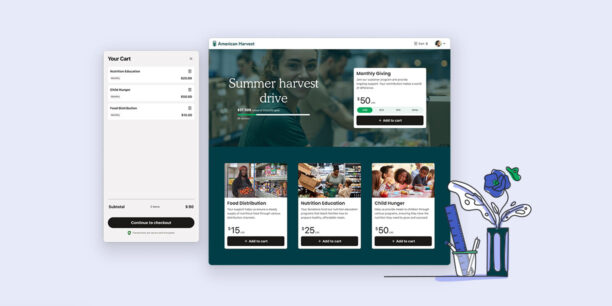The 6-Step Guide to Writing a Nonprofit Business Plan in 2023

Request a Demo
Learn how top nonprofits use Classy to power their fundraising.
Nonprofit business plans aren’t just nice to have—more like need to have.
Without a plan, you’re just throwing noodles at the wall and hoping something sticks. That might get you a win now and then, but that’s a hard recipe to replicate.
Now, we’re not suggesting you spend months creating a black-tie, formal nonprofit business plan to frame on the wall or shove in a file cabinet somewhere (do they still make those?).
Not at all.
Instead, we’re advocating you take the time to put your grand ideas and strategies in writing to:
- Chart a course from where you are now to where you want to be
- Check your decisions against your plans
- Fundraise with tip-top efficiency
- Earn loans and grants
- Impress and win over big-time donors
- Convince qualified board members to join the team
It’ll take a little time (there’s no getting around that), but a nonprofit business plan can be a game changer for your organization. Trust us—it’s worth it.
Plus, we’ll walk you through every step along the way. Below, we’ll get into the nitty-gritty details of what a nonprofit business plan is (and isn’t), why you need one, and six steps to creating one that keeps you on track better than a map and compass.
What Is a Nonprofit Business Plan?
A nonprofit business plan outlines your business’ current situation and provides a roadmap for reaching your desired position. It explains your strengths, weaknesses, target market, opportunities, and fundraising strategy at a glance.
That said, your business plan doesn’t need to be a novel, so keep it as short and sweet as possible. It may grow longer as your organization grows and your needs become more complex, but you never want it to become long enough that it’s intimidating to open.
Nonprofit business plans typically include a few common elements:
- Executive summary
- Nonprofit description
- Need analysis
- Products, programs, and services descriptions
- Operational plan
- Marketing plan
- Impact plan
- Financial plan
However, it’s your plan, and you don’t have to include all these sections or stick to these conventional naming methods. Sure, you’ll want financial stakeholders and donors to understand it, but make it your own.
The thing to remember is that your nonprofit business plan isn’t a one-and-done document. It’s a living, breathing record that you should reference and update regularly. That reference part is critical, as it’s there to guide your actions. So look at your plan often to ensure you’re headed in the right direction.
Why You Absolutely Need a Nonprofit Business Plan
You’ve likely heard the stories of famous nonprofits, CEOs, and entrepreneurs who found success without a plan. Yes, it happens, but they’re the exception—not the norm. Trust us—it’s best to have a plan.
Reasons you need a nonprofit business plan
- You’ll outline your goals and objectives to achieve your mission
- You’ll understand your current situation and your target market
- You can identify roadblocks before you run into them
- You’ll determine how you’ll avoid challenges and capitalize on opportunities
- You build awareness for your cause
- You’ll raise funds from donors
- You’ll attract board members, volunteers, and supporters easier
- You can better inspire your team to reach milestones
- You’ll have a way to hold yourself accountable
How to Make a Business Plan for Your Nonprofit Organization
Conventional advice suggests that you get started with your executive summary and nonprofit description, but we’re going to do things a bit differently here.
Why? That method of building out a nonprofit business plan tends to stifle the creative juices. We’ll get to the operational plan, need analysis, and all that fun stuff soon, but let’s take a step back before we dive into those details.
So first, let’s identify your why.
Step 1: Identify Your Why
Figure out why your nonprofit exists. What’s the purpose? Is there a story you want to tell?
You’re just brainstorming here, so don’t be afraid to test different ideas and explore various rabbit holes—that’s all part of the exercise.
Ask yourself:
- What are your nonprofit’s goals and mission?
- Why does it matter? Why have you invested your personal wealth, time, passion, and energy into your nonprofit?
- What happens if you reach your goals? What happens if you don’t?
Answering these questions will help you get to the root “why” behind your nonprofit. Once you understand (and can articulate) your purpose, you’ll be ready for everything else.
Often, just having a powerful why is enough to convince donors, lenders, and volunteers. Yes, your financials and marketing plan also matter, but everyone loves supporting a good cause.
Step 2: Decide How You’ll Get From Point A to Point B
A business plan helps you get your nonprofit from one place to another. Sure, there’s often no single correct route, you’ll have to navigate your options to see which you believe is the best.
Ask yourself:
- What’s your nonprofit’s current situation?
- What’s going on with your organization?
- What makes you excited?
- What are you worried about?
Now, it’s time to figure out where you’d like to be, as opposed to what your nonprofit looks like now. This would be your vision of success in three to five years.
Once you’ve figured out your point A (where you are) and point B (where you’d like to be), it’s time to think about how you make the journey. What marketing strategies do you plan to use? How will you raise funds? Who do you need to bring to the team to make it happen?
Step 3: Describe Your Target Audience
Your nonprofit likely has a few audiences, and their needs are quite different. Take time to explore who these people are. You might not understand exactly what they need yet (and that’s fine), but you should take this opportunity to dive deep into their personas:
- Recipients: The people your nonprofit directly benefits. Who are they? Why do they need your nonprofit?
- Members: The employees and team members who make up your nonprofit. What makes them special? Why did they join your nonprofit, as opposed to all the other options?
- Donors: The people who financially support your nonprofit. Whether these donors range from $5 to $1,000 contributors, they all matter. What makes them give to your nonprofit?
- Volunteers: The people who give their time to support your nonprofit’s events and causes. Who are these givers? Why do they show up?
- Partners: The board members and businesses that back your nonprofit. Who are they? Why do they support your nonprofit?
Going through this exercise helps you see all the different people involved with your nonprofit. Each has unique needs to address and deserves your attention as you outline goals and strategic plans.
Do you feel like you lack information about any of these specific groups? That’s all right. Notice the gaps in information and make it a priority to better understand them. Yes, gaining those insights won’t be an overnight intervention, but at least you can create a plan for how you’ll learn more about them (e.g., surveys, one-on-one conversations, focus groups, and observations).
Step 4: Find Your Roadblocks
There’s always room for improvement, even if everything appears to be going smoothly, which you can address during planning.
Ask yourself:
- What are you worried about?
- What’s stopping your nonprofit from hitting its goals?
Then, think about your current obstacles:
What’s hindering progress today? That might be finding a qualified board member, or it could be raising sufficient funding. It also could be getting volunteers to show up at events or finding a way to distribute resources efficiently to your nonprofit’s recipients.
Now, think about barriers you see down the road:
What problems do you foresee years from now? That might be losing donor interest or key partnerships or not adequately growing your team to keep up with demand.
In short, avoid being bashful or covering up issues. After all, this is your business plan—where you honestly address these things.
Once you have a good idea about the problems that need solving, start to think of solutions. Some of these could be as simple as allocating more funds to your hiring team. Others might be more difficult, such as learning how to turn one-off donors into lifelong recurring patrons.
Step 5: Outline Your Fundraising Plan
Fundraising is at the heart of just about any nonprofit. After all, by definition, your organization’s goal isn’t to generate a profit for your owners—it’s to operate and provide a benefit for the public or a particular group. Since you’re not making money by offering goods and services, you’ll need to rely on fundraising for financial support.
Think about how you’ll raise money for your nonprofit. What fundraising ideas will you use? Some ideas include:
- Host a raffle
- Run a car wash
- Invite supporters to a race
- Host a sports tournament
- Surprise donors with a giveaway
- Put on a concert
- Host a silent auction
- Invite supporters to a gala
- Create a game night
- Put together a scavenger hunt
These are just a few ideas to get your creative juices flowing. If you want the best-of-the-best ideas (in more detail), check out our 77 Fundraising Event Ideas for Nonprofits and Charities.
It’s also important to remember that fundraising and volunteering go hand in hand. So while you’re planning your fundraising strategies, start to think about your volunteer program.
Ask yourself:
- What events will require volunteers?
- When will you need the volunteers?
- Who will volunteer at your events?
- How will you find the volunteers?
Step 6: Fill in Your Nonprofit Business Plan Outline
Finally, you’ve made it to the last step in putting together your nonprofit business plan. By this point, you’ve answered just about every detail that goes into your plan—we just did it in a not-so-boring, roundabout way.
Let’s fill in the details. Nonprofit business plans typically have the following elements:
Executive Summary
Your executive summary introduces your nonprofit business plan and an overview of everything inside. This summary convinces readers to turn the page and learn more—it’s where you sell your nonprofit. So borrow ideas from Step 1: Identifying Your Why to drive home the mission and importance of your nonprofit.
While your executive summary is the first document in your nonprofit business plan, it’s best to write it last. You’ll be able to articulate your summary better once you’ve filled out all the other sections.
Nonprofit Description
Explain what your nonprofit does, who it helps, where it’s at, and where you aspire for it to be. This means describing your target audience and making your constituents come to life. You’ll also want to highlight unique opportunities that’ll excite your reader—whether that’s a volunteer, donor, or board member.
Need Analysis
Your need analysis (also known as market analysis) supplies research and data to support your nonprofit. It explains the problem and how your nonprofit provides a solution.
For example, if your nonprofit helps veterans, you might underline statistics concerning: disability, financial problems, unemployment rates, and homelessness. Metrics like this can help readers understand the importance of your nonprofit and the scope of the issues that need resolving.
Products, Programs, and Services
Here’s where you explain how your nonprofit addresses the problems or opportunities presented in the need analysis. Outline what products, services, and programs you provide. Be sure to also detail the pricing and costs (if applicable).
Operational Plan
Your operational plan details the day-to-day operations of your organization. For example, it might describe how you work with partners, suppliers, and volunteers to execute events and fundraisers.
Spotlight the people behind your organization by putting names and descriptions to the faces. Here are a few individuals to consider highlighting in your nonprofit business plan:
- Management team: Employees full-time and part-time
- Board of directors: Members of your board and their credentials
- Volunteers: Nonemployees helping the cause
- Donors: People who’ve made very generous donations
- Partners: Businesses and organizations you partner with regularly
Marketing Plan
Describe the campaigns, outreach events, and initiatives you coordinate to reach beneficiaries, donors, and volunteers. Here’s where you’ll include all the details about your target audiences.
Your marketing plan includes any of the channels you use for marketing or communication, such as:
- Social media
- Text
- Webinars
- Website
- Landing pages
- Video
- Events
Be sure to include channels you currently use and explore methods you’d like to invest in if you had additional staff or funding.
Impact Plan
Nonprofits seek to create lasting change. And your impact plan is where you specify the transformation you’d like your organization to make.
Outline your goals and attach them to numbers (wherever possible). For example, you might want to feed 1,000 struggling families or find housing for 250 immigrants in need.
Also, don’t forget to include the people you’ve helped already. While you might aspire to help more, it helps give perspective to reflect on those your organization has already served.
Financial Plan
Nonprofits need money to operate, but money doesn’t grow on trees. So this is where you’ll plan for raising money (and show donors who want to know how you spend their contributions).
Here’s what to include in your financial plan:
- Financial status: Describe your current financial situation and projections. Include all your financial statements: income statement, balance sheet, and cash-flow statement.
- Funding sources: List out grants and significant funds you’ve received.
- Fundraising plan: Outline how you plan to raise additional funds.
- Funding gaps: Explain where you don’t have enough money and how you plan to manage the gap (e.g., fundraise, trim the budget, or forgo).
- Spending plan: Detail how you plan to use donations (e.g., services, hiring, and marketing).
Copy/Paste Nonprofit Business Plan Template
Copy and paste the nonprofit business plan template below and fill in the blanks.
- Executive Summary: Recap your nonprofit business plan.
- Nonprofit Description: Describe what your nonprofit does, its current situation, your mission statement, and goals.
- Need Analysis: Use data to underline the market need to support your nonprofit’s existence and secure funding.
- Products, Programs, and Services: Explain how your nonprofit addresses the market need.
- Operational Plan: Explain the day-to-day operations of your nonprofit and spotlight the people who’ll make it happen.
- Marketing Plan: Outline the channels and methods you use to drive your campaigns.
- Impact Plan: Describe the impact you’d like your organization to make and include the impact you’ve already had.
- Financial Plan: Explain your financial status, future projects, and funding gaps.
Put Your Nonprofit Business Plan Into Action With Classy
Creating your nonprofit business plan is just the beginning—now, it’s time to act. Whether you need to raise funds, host a virtual event, or manage your donations, Classy is the platform you need to do more good.
Don’t just take our word for it. See for yourself.
Schedule a call with our team to get a hands-on walk-through of Classy. You’ll see firsthand how Classy can help you fundraise, attract donors, gain supporters, and streamline all your nonprofit’s processes to achieve your goals.
Learn more about Classy.
Subscribe to the Classy Blog
Get the latest fundraising tips, trends, and ideas in your inbox.
Thank you for subscribing
You signed up for emails from Classy
Request a Demo
Learn how top nonprofits use Classy to power their fundraising.
 Explore Classy.org
Explore Classy.org 

